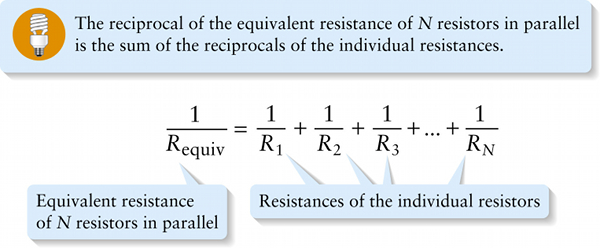Equivalent resistance of resistors in parallel (18-20)
Question 1 of 2
Question
Equivalent resistance of N resistors in parallel
{"title":"Equivalent resistance of N resistors in parallel","description":"Correct!","type":"correct","color":"#99CCFF","code":"[{\"shape\":\"poly\",\"coords\":\"82,133\"},{\"shape\":\"rect\",\"coords\":\"10,16,12,16\"},{\"shape\":\"poly\",\"coords\":\"144,22\"},{\"shape\":\"rect\",\"coords\":\"1,29,16,46\"}]"} {"title":"Resistances of the individual resistors","description":"Wrong","type":"incorrect","color":"#ffcc00","code":"[{\"shape\":\"rect\",\"coords\":\"136,26,154,49\"},{\"shape\":\"rect\",\"coords\":\"190,28,206,50\"},{\"shape\":\"rect\",\"coords\":\"83,28,101,47\"},{\"shape\":\"rect\",\"coords\":\"273,26,288,48\"}]"}Review
Equation 18-20 tells us that by combining resistors in parallel, we create a circuit with a smaller equivalent resistance than any of the individual resistors. For the special case of two identical resistors R in parallel, the equivalent resistance is given by
1Requiv=1R+1R=2R so Requiv=R2
The equivalent resistance of two identical resistors in parallel is onehalf that of each individual resistor.

